
 Aquila nearly completed, Impero 1940-43
Aquila nearly completed, Impero 1940-43
The Aquila and Sparviero aircraft carriers were among the well-known unfinished ships of WW2. Both proceeded from ideas developed in 1928-1930 as a faction milited for their development, in the country which invented the concept of strategic bombardment, by General Douhet.
The uncompleted 1916 Carraciolo class super-dreadnoughts were broken up due to the Washington treaty, and in WW2, the Capitani Romani class cruisers and Medaglie d’Oro class destroyers and many submarines were never completed, as the last of the Litorrio class, Impero. But the Aquila aircraft carrier would have been a remarkable ship, for her capabilities, despite being built in such a short time. She was nearly completed and started early trials when Italy surrendered in September 1943.
Mussolini’s “Aircraft Carrier Italy”
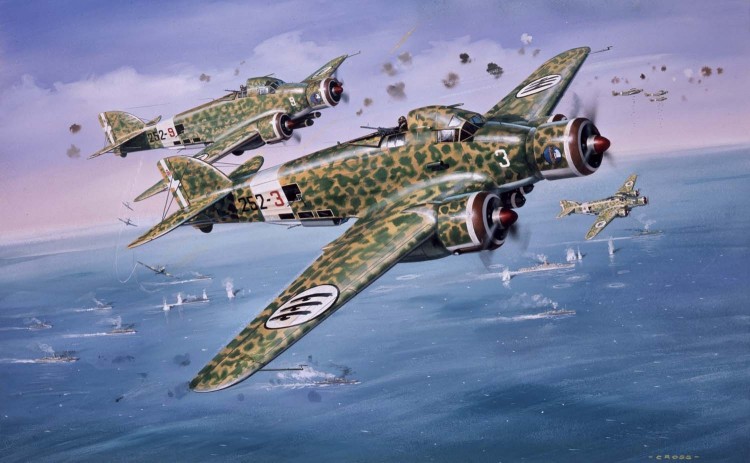
Savoia-Marchetti SM.79 Sparviero, the workhorse of the Regia Marina throughout the war.
Part of the Regia Marina high command, and Mussolini himself, considered an aircraft carrier superfluous in its position: Arguably the central geographic location in the Mediterranean and shape of the peninsula made it the best “natural carrier”, fitting in the objective of a “Roman lake”. Mussolini himself boasted this “aircraft carrier Italy” was unsinkable. However the reality of warfare soon recalled the necessity of a true carrier: The Tarento raid was one of many demonstrating the issue. The greatest problem was that coordination between the fleet and air force. It range from problematic so simply inexistant. Bombers and torpedo bombers were good, especially those of the Savoia-Marchetti SM.79 types, but they were never where it mattered. The latter were fast at 450 kph, with a range of about 1,000 m (1,600 and 3,300 ft), and could carry two torpedoes, although one was more current, of the standard 457 mm model.
The Regia Aeronautica’s anti-ship aviation
The Aerosilurante unit was created in July 1940 and crews had little time to practice (col. Moioli). They learned on the fly, quite literally. Their best success was to badly damage the heavy cruiser HMS Kent. They also attacked shipping in Alexandria, sank a merchant ship in Sept. 1940, and in October also badly damaged the cruiser HMS Liverpool. Both ships were written-off for almost a year in repairs and HMS Glasgow in Suda Bay, Crete. In 1941 they would also damage HMS Manchester and sank a destroyer, HMS Phoebe, HMS Nelson, badly damaged the destroyer HMS Jackal and sank the SS Imperial Star, Empire Pelican, Empire Defender, Glenearn and Xhakdina.
In 1942, they torpedoed again HMS Liverpool, just repaired near Malta, the steamer Tanimbar and they finished off HMS Bedouin. When attacking a convoy (Operation pedestal) they sank HMS Foresight and the merchant ship MV Deucalion. Later they sank a Flower-class corvette and a merchant ship, and badly damaged HMS Arethusa. They also damaged HMS Indomitable 16 July 1943 but this was their last success.

The Regia Aeronautica was primarily an independent air force subordinated first and foremost to the Army. There was no “fleet air arm” per se, and planes were attached by regional squadrons to various task, but without much centralisation. There were good marine planes however, like the CANT Z.506 Airone, a beautiful trimotor floatplane with two large floats under the engine nacelles. They were purely coastal defence planes, the equivalent of torpedo boats, carrying a single 816 kg (1,800 lb) torpedo at 350 km/h (220 mph, 190 kn) and on around 2,000 km. However only 350 were built, introduced from 1936. The main problem, like for the SM.79, was the lack of power of the engines, around 750 hp, a problem that plagued Italian aviation during WW2, solved by procurement of German engines.
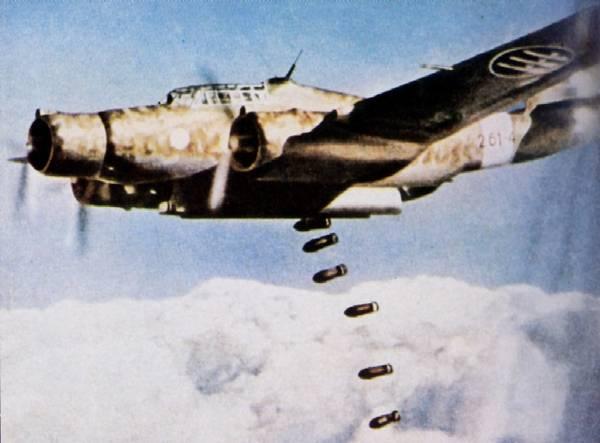
The upgraded CANT Z.1007 appeared in 1940 to replace both the Z506 and SM79. Called “Alcione” these were heavier but more powerful, with three Piaggio P.XI R.C.40 14-cylinder which developed 990 hp each, capable of flying at 458 km/h (285 mph, 247 kn) and carrying two 450 mm (17.7 in) 800 kg (1,800 lb), torpedoes.
In all, 660 were built; but apart the raid of Malta, they played a limited role over sea.
Guiseppe Miraglia: The exception
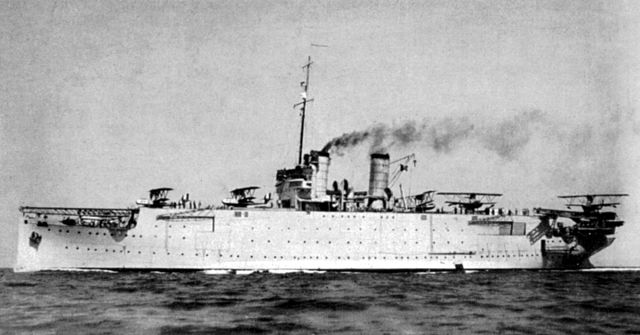
The converted state railway ferry could carry and operate in WW2 17 IMAM Ro.43 Idro, served by cranes and two steam catapults. She has been rebuilt in 1929 and was used like for the French Commandant Teste, as a mobile reconnaissance base. However, she was slow and therefore would not keep up with the fleet. In 1940, she was used as as aircraft transport and training vessel for floatplane pilots in home waters. After the Armistice of 1943 she ended in Malta, and stayed relatively inactive afterwards. In the 1930s the relative failure of the concept did not pushed the cause of aircraft carrier advocates in Italy, the country of Douhet.
Advocates of a carrier
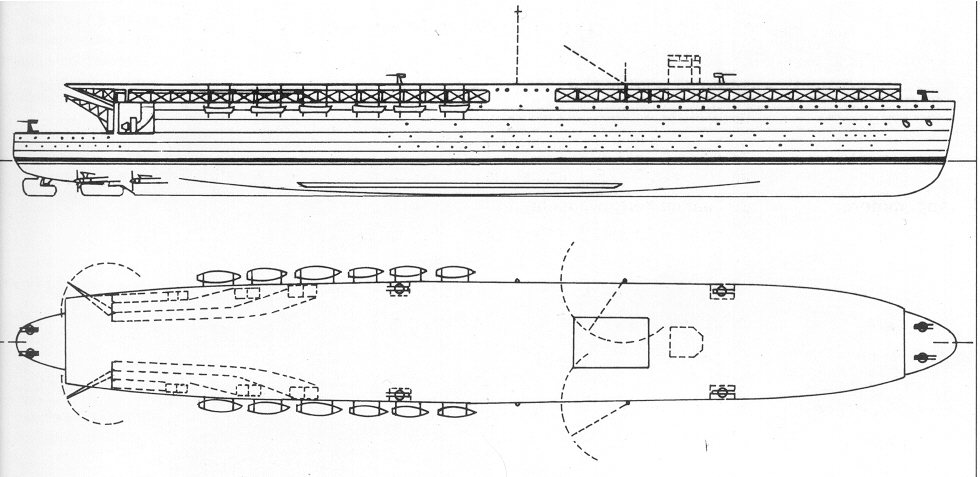
An abandoned conversion project of the Caracciolo.
During the interwar, the Italian military as well as political circles debated the role of aircraft carriers for the Regia Marina. Gino Ducci, the chief of staff in the early 1920s, Romeo Bernotti, his assistant and Giuseppe Fioravanzo argued Italy needed a fleet air arm, and this plan included also the construction of aircraft carriers, plus updated naval academies.
They faced the anti-air faction in the Navy, notably Mussolini himself and the Army, which in part wanted full control on the Regia Aeronautica, but allied with some politicians over cost issues and overall practicality. In the end, many were aware of Italy’s limited industrial capacity, cramped shipyard and little capital to develop the fleet further. The Miraglia was at best a compromise. Even the rivalry with France, with the latter converting a battleship into the aircraft carrier Béarn, entered considerations. However Mussolini was more concerned by parity in terms of capital ships and scrapped aircraft carrier conversion projects.
The other counter-arguments presented were connected always to Italy’s geography.
1-The Regia Marina was expected to operate primarily in the narrow confines of the Mediterranean
2-The navylacked a fleet air arm and there was no plan to develop one.
3-Carriers were expensive, and unproven.
4-France seemed not to commit in such endeavour (The Joffre class was projected in 1939 only)
5-The Italian coastal area allowed an extensive reach of the aviation.
6-Italian islands (Pantelleria, Sicily) were “natural” aircraft carriers, extending this reach to North Africa if needed and Mussolini’s plans to conquer Greece and the Balkans later would, and in case of war, Sardinian Corsica, Malta, Cyprus as well would have further extended the reach of the Regia Aeronautica if Mussolini’s ambitions were fulfilled. There were ample demonstration by the Luftwaffe that indeed, aviation was a threat for navies in this theater of war, even without an aircraft carrier. The carrier scenario only arranged the Royal Navy.
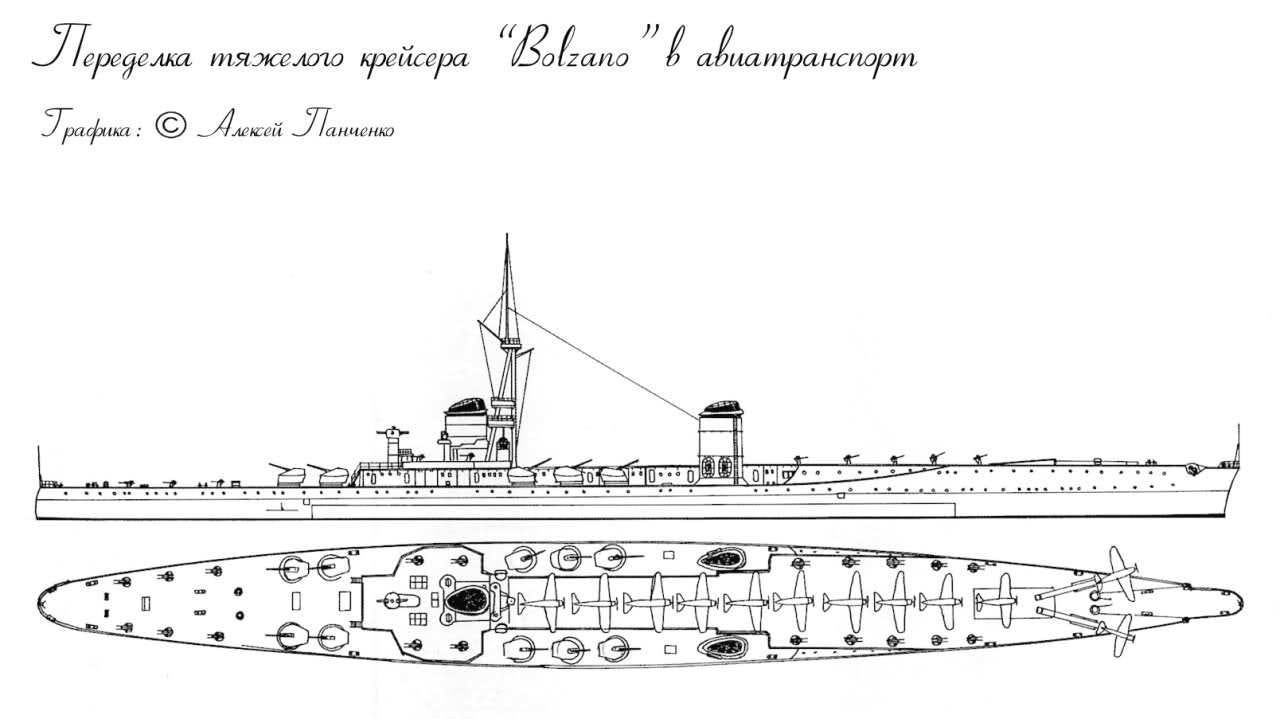
A conversion project of the Bolzano in 1941
Conversion of a liner as an aircraft carrier was not new: This has been already be object of a sturdy in late 1935, as relations degraded quickly between Italy and the United Kingdom around Ethiopia. The high command estimated aviation support was necessary far from home, and the Navy could bring this support in case of a conflict. It was well known that the Royal Navy had many aircraft carriers on her side. Rather than a newly built ships, such conversion, already done on the Miraglia, saved time and money. The study also envisioned a conversion of the transatlantic MS Augustus.
In 1938, with the Sudeten crisis, the aircraft carrier question made a come back, as alternatively the conversion of the heavy cruiser Bolzano. The project of was studied in detail by the famous engineer Giuseppe Rota. He considered razing the superstructures and leaving the aft 203 mm turrets and installing four catapults. One was to be placed on the main deck, and three laterally, plus a small island installed on the starboard side of the ship, and a hangar to serve a dozen fighters.
In 1940 and 1941, a serie of battle saw British planes shattered the last hopes of the Regia Marina to win without a carrier. The battle of Punta Stilo, notably turned to disaster because of British aviation, Fairey Swordfish torpedo bombers which hit the Vitorrio Veneto, forced to retire, and the Pola, which was assisted by two other heavy cruisers of the Zara class, all lost by during the night by close gunfire by British Battleships. This event saw the best Italian cruiser class decimated, loss which the Italian Navy could ill-afford.
The defeat was a shock for the admiralty, and of course the raid of Taranto in November 1940 were a clear reminder that air power was not a joke if well used. On paper the Royal Navy was numerically inferior to the Regia Marina, so the conversion of existing ships into aircraft carriers became urgent.
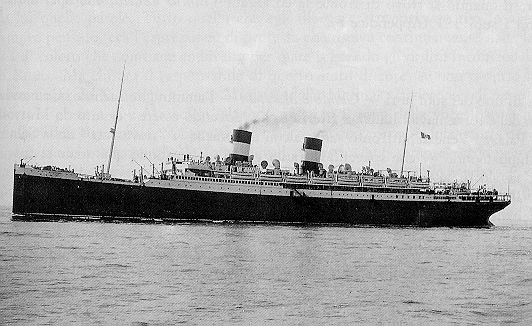
A reunion of the admiralty took place in late 1941 to choose potential candidates for conversion. Soon, the Transatlantic Roma was found suitable. She was large enough, recent (barely 15 years old) but needed an overhaul of her machinery. Roma was originally built for the “Italian General Navigation” company of Genoa, by Ansaldo shipyard in Sestri Ponente. Roma was launched on February 26, 1926.
Bonfiglietti’s Carrier designs
About Lt. Gen. Bonfiglietti
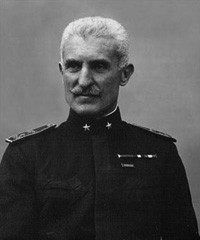
Lt. General Filippo Bonfiglietti was born in Tivoli quarter, Rome in 1868. A cavalry sergeant in 1882, in 1892 he was graduated a civil engineer, naval school of Genoa two years later, and supervised in 1896 the construction of the revolutionary Regina Elena battleships.
A captain in 1904, he was in the ministry of the Navy in Rome and became a Lt. Colonel in 1913. He was posted during the war at the Genoese technical office fior the Navy, and started teaching at the engineering faculty for naval construction from 1917. He took the head of the technical bureau of Castellamare de Stabia NyD, and then, the yard itself. In 1924 he was promoted at the head of the naval construction in the Ministry in Rome and later general of the naval engineering corps. He also headed the information and studies office in the design committee, and later a lt. General until 1931 in this office. He retired, but went on working on engineering projects, like the port of Loano, where he died in 1939.
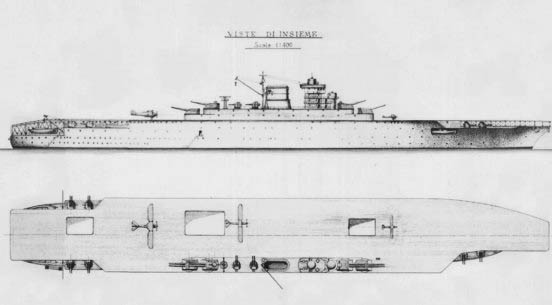
Bonfiglietti’s carrier design A
But of course on of his greatest legacy was his work on Italian aircraft carrier projects, which for he milited. He notably designed the Zara class cruisers and Bolzano, and from 1929 a 770 tonnes, 34 knots TB. His 15,000 tonnnes aicraft carrier project had 203 mm guns and about 40-50 aircraft.
He would design four variants of the same project, one of which (nearly adopted), strongly resembled the contemporary USS Lexington class. His blueprints resurfaced in 2008 and were used for a long article in Storia Militare, and was published therafter in Warship 2015 by John Jordan.
Bonfiglietti’s 1929 preliminary designs
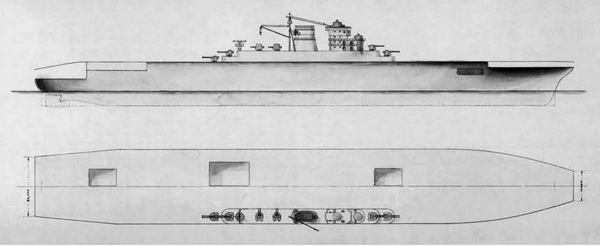
Bonfiglieti variant A showing its strong resemblance in general concept to the Lexington class, with 8×8 8-in guns in twin turrets, large funnel and tower bridge. It was derived from the Trento and Bolzano hull he studied and were very fast, pure fleet carriers.
His design A to D had the same powerplant rated for 70,000 shp, 1800 nm at 29 knots, 4,200 at 2 knots, and a triple bottom to store oil, two sets of steam turbines with reduction gear fed by two groups of three watertube boilers. They were however smaller than those adopted on the Trentos. They were indeed spaced to left room for the Pugliese ASW protection system. There were also six turbogenerators, 180 KW each. The power distribition derived from the Zara class.
The propellers were 4.4 m in diameter and run at 260 rpm max. The internal hull layout allowed the ships to survive with three compartments flooded. Bonfiglietti took precaution for heating transmission when the ships was at full speed, to not overheat the hangar’s floor. There was an isolating material and air circulation vents.
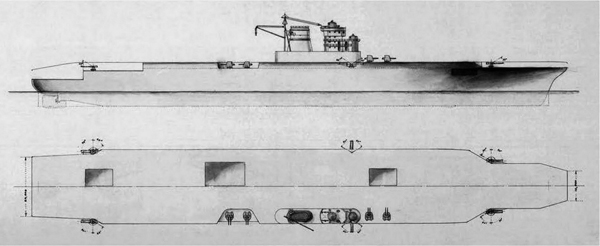
Bonfiglietti design B
Complement as specified late 1928 by the naval staff was 1112 officers and men, notably 78 officers, including 62 for the air force. He submitted his design in December 1929. He really hoped this could be approved for further work, but the admiralty took her time. There were discussions and exchanges of letters with the London naval attaché over possible smaller carrier designs desrived from cruiser hulls, on which Bonfiglietti worked in 1930 and which were called variant B, C and D.
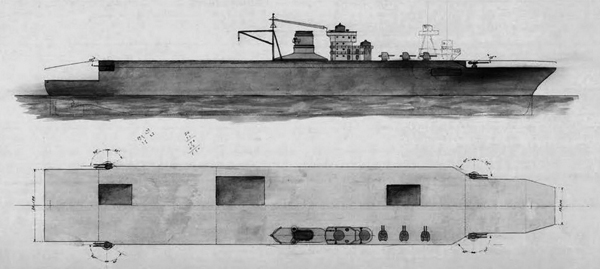
Bonfiglietti variant C
The A and B displaced 14,000 tonnes and recalled the USS Ranger in general arrangement, while the C was no more than 10,000 tonnes. Among othe r changes, the flight deck was shorter, protection lighter, armament reduced to secondary dual purpose guns. However the general yalout and even the aircraft carrying capacity was almost unchanged. The C variant was the weaker however, with less planes, no Pugliese system. He proposed all these as a base for discussion, hoping his well-thought out original design A would be chosen. He also specified using diesel to reduce the island size and maximize the landing deck surface and efficiency.
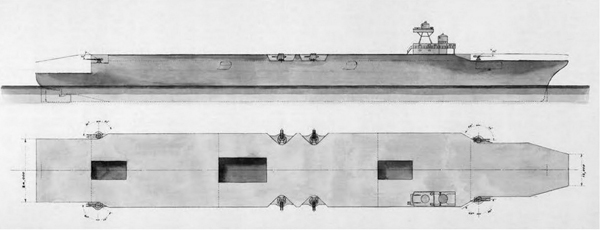
Bonfiglietti variant D
After Bonfiglietti retired, “Our Maritime policy” by Bernotti was still the rule book for the Regia Marina, based on the position the navy took at the conference of London in 1930. In 1931, Bonfiglietti however released his fourth design “D” which he sent to the design committee, based on an agreement in the conference between Italy and France on the question of remaining tonnage, 34,500 tonnes of aircraft carriers;
Bonfiglietti argued against a single carrier of 27,000 tonnes or three of 10,000 tonnes which would have been too small with too few aircrafts to operate effectively. He proposed two carriers of 17,000 tonnes instead, the object of design D, which ended at 11,500 tonnes. This D still had a 200 m long flight deck, 28 m wide. Top speed was about 26 knots, and the exhaust ducts were relocated on the sides, eliminating the funnel and thus making the island way smaller and without much interference, but this provisioned diesel engines and generators.
Its planned armament comprised four twin 120 mm DP guns and four twin 100 mm HA located on a deck level below the flight deck. This arrangement left a 140 m long area available for landing, with a 10° incline at the end. Three aircraft lifts were on the axis, centerline, reinforcing also the landing deck. Instead of the Pugliese system, tight compartmentation ensured a layered defense agains torpedoes and flooding.
In the end, 30 aircraft were carried, 12 fighter, 8 bombers, and 10 recce planes, provided these were readily available, but up to 42 with folded wings aircrafts if the project was approved. He precised the design was to be the object of much rework and developments to be completed. However in November 1931 there were just a mention about the design and no decision was made. The aircraft carrier question did not resurfaced before long after the war broke out.
Design of the conversion
The first step in the process was to choose the two liners suited for such conversion: MS Augustus and Roma. The SS Rex, famous Italian transatlantic flagbearer, one of the great civilian prestige successes of the Fascist regime, the 45,800 tons, 270 m long, 28 knots liner would have made formidably large carriers, but Rex was laid up at Genoa in late 1940, later Trieste to avoid bombings, and Pola. She will be sunk by the RAF in September.
SS Roma

The 30,800 long tons (31,300 t), 21 kn (39 km/h; 24 mph), 215 x 25 m ocean liner Roma was less recent than the Augustus. She was the lead ship in a class ordered by the Navigazione Generale Italiana as transatlantic ocean liners, from the Ansaldo shipyard. The was launched in 1926, named SS Roma, with a steel hull, Baroque interiors, teak deck, 32,583 GRT displacement, and was identified by the signal code letters ICEV. She was launched on 26 February 1926, Completed in September 1926 and in service by 21 September 1926.
Rome diverged from her sister ship Augustus as having diesel engines, connected to eight turbines on four shafts. Steam came from 9 double ended and 4 single ended boilers, thirteen in all. Top speed as designed was 22 knots. Carrying capacity was 1700 passengers: 375 in the first class, 300 in the second, 300 in the intermediate and 700 in the third class.
She had two funnels painted repainted after the company merged with the Lloyd Sabaudo and Cosulich Line, to form the Italian Line and during her service on 30 January 1932, she collided with the American ocean liner President Roosevelt in New York. The latter was rammed, but repaired and returned into service.
A rocky conversion decision
The important date was June 1940, when Mussolini sanctioned the conversion of the Roma into an auxiliary carrier. This was to a simple, fast conversion in the guise of the British HMS Argus, but even more simplified, with a full-length deck deck and small hangar for support operations. But on 7 January 1941, two month after Taranto, Mussolini decided to change the conversion into a full-blow fleet aircraft carrier.
Her top speed being inadequate for military service her power-plant had to be entirely modernized, diesels retired and new turbines and boilers added to reach 30 knots as specified.
Her conversion was to start soon after when she was ordered, but the Regia Marina staff came with many objection on 27 January 1941: Cost issues, designing from scratch catapults, an arrester gear and elevators, folding wings conversion of existing aircraft and many other aspects, for a considerable total cost and conversion duration of at least two years.
The situation could dramatically change in the interval and budget was limited (of should be limited as thought) to emergency maintenance and repairs of existing ships. Later budgets were stretched further for the construction of new destroyers (Soldati and Medaglie d’Oro), new torpedo boats (Ciclone and Ariete), submarines, ASW corvettes (Gabbiano class) and even new cruisers, the “Capitani Romani” as the 6th of the Condotierri group, Ciano class, were cancelled in June 1940. In addition, the Italians referred to the problems and delays already encountered by the Germans with the Graf Zeppelin or the Luftwaffe own’s antiship capabilities, demonstrated when HMS Illustrious was almost sunk by Stukas (The Regia Aeronautica was about to receive about 200 of them).
Mussolini heard these arguments and postponed the conversion, until the battle of Cape Matapan on 21 June. The absence of a carrier and its advantages was then obvious to the Regia Marina which rescinded its complaints. Mussolini reopened the case and ordered the ships again.
HD photo of the Aquila in La Spezia after the war (reddit)
Aquila conversion Design
The “Eagle” and “Falcon” were similar, but the conversion design was not the same. Their powerplant differences mattered as well as the financed to achieve the conversion. Falco, ex Augustus, would be converted later in 1942, in a much simplified design reminiscent of the first conversion project in November 1940.
The conversion of Roma, renamed Aquila in February 1942 to free the name for a fourth Litorrio class battleship, was started at Cantieri Ansaldo, Genoa, in November 1941. A conversion project of two years would meant she would have been serviceable by November 1943, yet at the time Italy had no hindsight on how the war would turn, in particular in North Africa.
Conversion process
The relatively large hull made a good base, although the waterline was less narrow than cruisers of the time, with the adequate powerplant it was thought suitable speed could be obtained. Moreover it was decided later to lengthen the hull to take advantage of this better output, obtaining finer entry lines. The greatest challenge was the fact both should be converted to military grade, meaning including protection aspects that did not existed in the original design, and a completely new arrangement.
Notably of course, the interior was completely gutted, back to bare walls and floors, and a very large opening cut to allow the total replacement of the original machinery. After the machinery was installed and the decks above sealed, the construction of a full-length hangar and associated workshops could start. It was certainly a much greater endeavour than just placing a flying deck above an existing ship, and time was gained only because the bottom of the hull already existed, as the shafts and rudders. Practically all the rest was changed, not far away from a brand new construction.

Aquila fitting out in Genoa, circa 1943
Protection
Protection-wide, changes were considerable: The first step was to add deep bulges either side, not only to improve stability (essential for a carrier), and provide some torpedo defense. It was not yet as thorough as the Pugliese system, but more efficient than a simpler deep-layered compartmentation. In addition, a reinforced concrete layer ranging from 60 to 80 mm (2.4–3.1 in) in thickness was poured inside the bulges for splinter protection. Conway’s states even this was 60 cm of concrete.
Also, 30 to 80 mm (1.2–3.1 in) thick armor plates were placed over the magazines and aviation fuel tanks. The latter were inspired by British models, composed of cylinders and/or cofferdams separated from hull by compartments filled with seawater. This safety measure intended prevented fracturing, and spread of volatile aviation gas, not because of a hit, but near-miss, as brutal vibration from the shock underwater was likely to provoke massive leakages.
Powerplant
To gain time, it was decided to use four sets of the new Belluzzo geared turbines built for the last two, just cancelled Capitani Romani-class light cruisers. The ships concerned were the Cornelio Silla and Paolo Emilio. These steam units were connected to eight thornycroft boilers, generated 151,000 shp (113,000 kW). They propelled the ships at 30 knots (56 km/h; 35 mph) as designed in trials, down to 29.5 knots fully loaded and in battle order. This was totally adequate for the fleet. 3600 tonnes of oil was carried also.
The machinery was arranged into four separate compartments. Each contained two boilers and one set of turbines, they were separated into two equal groups by a midship compartment.
Flight deck, hangar and island
The blueprints showed a single continuous flight deck, 211.6 m long by 25.2 m wide or 694 feet 3 inches and 82 feets 8 inches. This allowed the same flight operations as the Ranger or most British aircraft carriers of the time. This flight deck was partially armored: 76 mm (3.0 in) plate were placed over the aviation gasoline bunkers and aircraft ammunition magazines. The flight deck stopped short of the bow, but overhung the stern, with a round-down for better air flow. The hangar measured 160 by 18 meters, initially large enough to house only 26 planes.
Two lifts were provided, of equal size, 50 ft (15 m) and octagonal on shape. However they had only a 5 short tons (4.5 t) capacity. One was amidships, and the second not far forward. This design placed them far from the arrester wires for safety.
The Germans, which knew and approved the Italian design, had Demag contacted to deliver already tested compressed air-driven catapults. Each of these was created for the Graf Zeppelin, and was capable of a launching every 30 seconds. On Aquila, they were installed at the forward end of the deck, side by side, ans were taken from the stocks made for “Carrier B”, Graf Zeppelin’s sister ship. On the same move, the Italian technical commission sent in Germany in late 1941 also obtained five sets of arrester gear and other equipments belonging to the same cancelled carrier B.
However the Italian solution for handling planes from the hangar was peculiar, since they derived from the German system: A set of rails was installed from the elevators to the catapults. Aircraft were to be hoisted in the hangar, onto a portable collapsible catapult carriage. Elevated to the flight deck, they were trundled forward on the rails to the catapult, as on the Graf Zeppelin. A complication the allies avoided.
Aquila’s starboard-side island was much inspired by the 1930 designs by Bonfiglietti; There was a single large vertical funnel and a tall command tower on which were mounted the fire control directors for the 135 mm (5.3 in) duel purpose guns. One bridge was the command bridge and above was placed the deck operation c&c bridge. No radar was provisioned, even though the Germans projected one large surveillance radar to be fitted in Graf Zeppelin.
Armament of the Aquila
The Aquila was to be fitted with a powerful onboard armament, less extreme but better balanced than in the 1930 design (4×2 8-in gun turrets).
Her original armament was to comprise eight 152 mm/55 (6 in) in four twin turrets for and aft of the main island, twelve single masked 90 mm/50 AA guns, and 104 37 mm/54 AA guns in twin mounts, but it was revised later:
Aquila’s final main dual purpose artillery was to comprise four twin 135 mm (5.3 in)/45 cal guns. They came straight from the same cancelled last two Capitani Romani-class cruisers as the powerplant. They could only elevate to 45° but could fire fuse delayed explosives with shrapnel to create a barrage. In addition, she carried twelve Breda 20 mm (0.79 in)/65 cal. anti-aircraft (AA) guns in single mounts, placed fore and aft on the island.
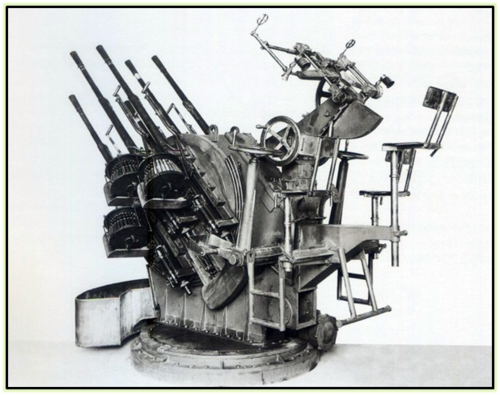
Sextuple 20 mm Breda mount, model 38, built for the Aquila.
Planners also intended to add twelve of the brand new 65 mm (2.56 in) AA guns, on sponsons below flight deck level like allied 75 mm mountings. but the ambitious ordnance fed automatically at 20 rpm were mere prototypes in 1942 and still not ready in late 1943. In alternative, additional twelve Breda 20 mm would have been mounted instead in case the ships would have been completed sooner. Final plans were even more radical, intended to use no less than twenty-two sextuple 20 mm AA mountings (132 total) in addition to the twelve 65 mm mounts. This would have made the Aquila one of the most heavily armed carrier in the world in 1943, an AA defence way above the usual Regia Marina standards, and very much the fruit of wartime reflection.
The Original blueprints of the Aquila are lilely to be lost, since i can’t find it anywhere on internet. But interpretations of the general outline design exist which gives a good sense of the ships’s look, very reminiscent of the German Graf Zeppelin.
Specifications of RN aquila |
|
| Dimensions | 207.30 (wl) 211.60 (oa) x 29.40 x 7.3m (680/759 x 96 x 24 ft) |
| Flight Deck | 216.20 (oa) x 25.30 m (70 ft 6 in x 83 ft) |
| Displacement | 23,130 t, 28,350 t FL |
| Crew | 1165 + 243 air personal |
| Propulsion | 4 shafts Belluzo turbines, 8 Thornycroft Boilers, 151,000 hp |
| Speed | 30 knots (56 km/h; 35 mph) |
| Range | 5,500 nmi (10,200 km; 6,300 mi) at 18 kn (33 km/h; 21 mph) |
| Armament | 8x 135mm/45, 12x 65mm/64, 132 x 20mm AA, 51-66 aircraft. |
| Armor | Belt: 80 mm, decks 60 mm |
Aircraft complement of Aquila
The same process than in Germany took place to find suitable carrier-based aircraft and test them for modifications. Trials took place at facilities in Perugia and Guidonia. Ultimately the Regia Aeronautica settled on the SAIMAN 200 (recce) and for fighters-bombers, the Fiat G.50/B and Reggiane Re.2001 OR Serie II. They were modified and pitted each others in a serie of tests in 1942-43. Feedback in March 1943 from German engineers and instructors proposed to instruct pilots of the 160 Gruppo C.T. of the Regia Aeronautica, on Ju 87C Stuka, if the latter was to be navalized as it was studied for the German aircraft carrier, with folding wings, arrester hook and catapult attachment points.
Saiman 200: This two-seat primary trainer from the Società Industrie Meccaniche Aeronautiche Navali was designed by Mario Bottini was introduced in 1940 and was thought as a possible reconnaissance biplane. Caproni-Vizzola built 115 aircraft and SAIMAN built 25, modified in early service due to many accidents. The Italian “tiger moth” was propelled by a 185 hp (138 kW) Alfa-Romeo 115 engine to 220 kph, and was given a range of 475 km (295 miles). It was unarmed but a possible ring-mounted Breda MG for the rear observer. It was eventually never selected.
The Fiat G50B was a two-seat trainer version of which 100 aircraft were built, but its role was to be a fighter/recce plane, eventually not selected.
In addition to the Stuka, Italian pilots trained in Germany also on the Arado Ar 96B trainer. but eventually comparative tests ended with the choice of the Re.2001 as a standard. This also confirmed by the Germans, arguing it was even better than the Bf 109T.
The winner: Caproni Reggiane 2001/G Falco II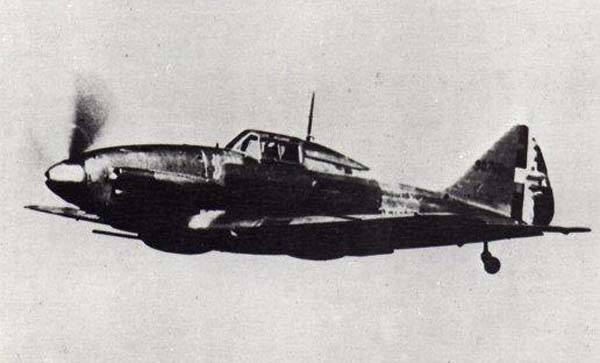
Re 2001-5
The more sturdy and proven Caproni-Reggiane 2001, derivative of the US Seversky P35 fighter (a 1939 ancestor of the P47 thunderbolt) became the main plane onboard, still in unfolded version to gain time. The RE 2000 was already well-liked by the Regia Marina, as an onboard fighter-bomber on board cruisers and battleships in 1942-43 where its replaced the Imam Ro43. Some projects were to even carry the 450 mm standard aerial torpedo. Using the same plane presented obvious maintenance and handling operations advantages.
Aquila was to receive a complement of 51 non-folding Reggiane Re.2001. They were multirole, 41 being stowed in the hangar deck and some 15 suspended under the roof to gain space. Ten were to be stowed permanently on the flight, solidly strapped and covered with tarpaulins. Of course Italian engineers with German help started to work on the folding-wing version of the Re.2001, allowing to stack in 1943 some 66 aircraft, but only a prototype was made before the Italians surrendered.
Interesting developments of the Regia Marina included the Re.2001 G/V which was a modified fighter-bomber, with reinforced structure to carry a single 640 kg (1,410 lb) bomb derived from a 381 mm shell from Littorio, and a small serie entered service, two G/Vs taking part in Operation Pedestal. This was the most serious attempt at making an Italian naval dive bomber.
In the end, only ten Re.2001s were actually fully converted for carrier use, with tail hooks, RTG naval radio equipment and two bomb racks for 650 kg (1,430 lb) of bombs. The idea was to use the plane for strafing but also diving attacks, although there was no specific additions for that (visor, bomb lever-launcher, aerobrakes). The Re2001 had two 12.7 mm (0.5 in) Breda-SAFAT machine guns above the engine cowling. One Re.2001G was tested at Perugia to carry a 600 mm torpedo and two 20 mm cannons, with two built in 1943. It had a lengthened tail wheel strut and single ventral mount, but this development never went past the prototype stage by November 1943. If so, the Italians would have used the most versatile carrier-borne plane of the war. Similar concepts appeared in the Royal and US Navies in 1944, which would end with models such as the Blackburn Firebrand or Douglas Skyraider.
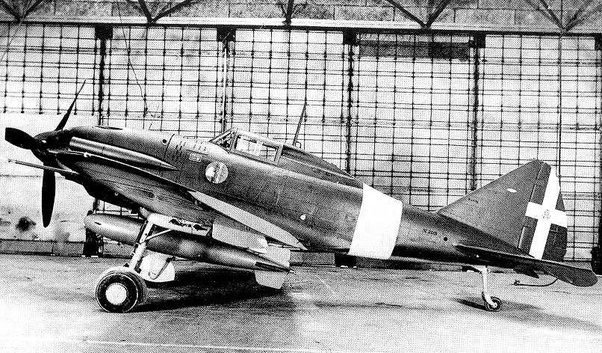
3-views of the Re2001-3
Re2001 Specifications:
Dimensions: 8.36 m (27 ft 5 in) x 11 m (36 ft 1 in) x 3.15 m (10 ft 4 in), Wing area 20.4 m2 (220 sq ft)
Weight: Empty 2,495 kg (5,501 lb), fully loaded 3,280 kg (7,231 lb)
Powerplant: Alfa Romeo R.A.1000 R.C.41-I Monsone V-12 inverted liquid-cooled piston engine 864 kW (1,159 hp)
License-built Daimler-Benz DB 601Aa, 3-bladed constant-speed propeller
Top speed: 542 km/h (337 mph, 293 kn), Range: 1,100 km (680 mi, 590 nmi)
Ceiling: 11,000 m (36,000 ft), Rate of climb: 13 m/s (2,600 ft/min)
Armament: two 12.7 mm Breda-SAFAT MGs (cowling), two 7.7 mm Breda-SAFAT (wings), 650 kgs bombs, see notes.

Re 2001 G testing a 600 kgs short aerial torpedo circa 1943, planned to be used onboard ships, including the Sparviero and Aquila (src quora).
Fate of the Aquila
Aquila laying abandoned in La Spezia – Src www.naviearmatori.net
Early tests and modifications
In August 1943, the arresting gear installed on the carrier.
It comprised four cables, but initial trials went badly and ongoing modifications and tests were not settled early in 1943; So much so that it was therefore proposed the aircraft would fly back after their mission to the nearest land-based airfield or ditch in the sea… Axis technicians at Perugia Sant’Egidio airfield recreated a mock-up of Aquila’s flight deck however in March 1943 made an arresting gear workable at last. But postwar US Navy evaluation and report on the captured Aquila concluded the arrangement would have lade these landings hazardous, compounded by the absence of a net for added protection.
Relocation and demise of the Aquila
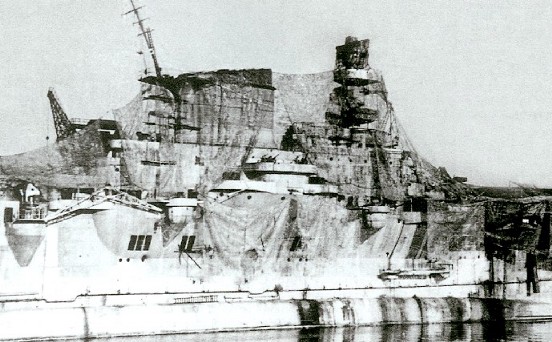
Aquila in la Spezia below camouflage nets – Src www.naviearmatori.net
Aquila was nearing completion and even had the time to pass her first static test in September 1943. Germany which occupied the area quickly seized the ship, placed under strong guard as they planned to end the completion and put her under service. However the Italian resistance (after Conway’s) managed to damage her, whereas little work was possible. Aquila received much more serious damage on 16 June 1944, during an Allied air raid on Genoa.
The Italian “co-belligerent” government in 1945 planned an action on the ship as they rightfully feared the Germans would use the uncomplete Aquila as a blockship, by default of completing her. The plan was to block the Genoa harbor. A commando operation was mounted, and divers from the former Decima Flottiglia MAS, launched their operations on 19 April 1945. They succeeded to partially cripple Aquila, prevented her to be towed, and she partially sunk in shallow waters. The Germans failed to tow her and soon Germany capitulated.
In 1946, a new towing attempt with refloating was done and Aquila was towed to La Spezia in 1949, where she was studied by and American commission and many photos were taken. The Italian Government considered her completion or conversion but eventually due to the lack of funds, it was decided to just scrap her in 1952. And thus ended the story of the only WW2 Italian aicraft carrier. Italy had to wait until 1982 to built another one, now the flagship of the Republica
Sparviero, the ill-fated sister ship
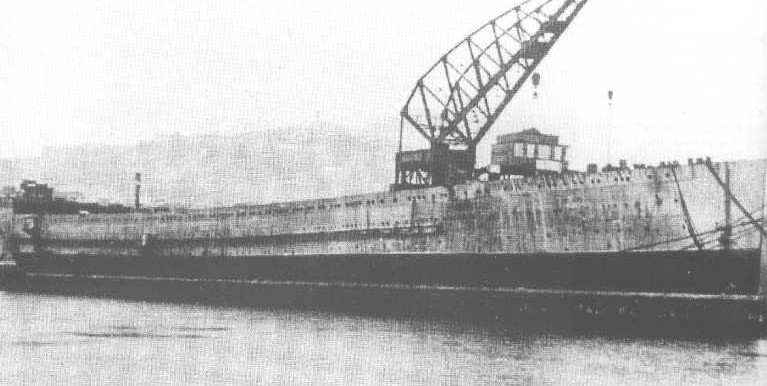
Sparviero at an unknown date in 1943, Genoa, under construction. The upper superstructure has been removed and a small provisional construction erected forward of the deck. Src forum.axishistory.com
This topic is good almost for a full-blown post so we will not dive into this in detail. The Augustus was taken over for conversion later in 1942. The goal was to make the fastest and cheapest conversion possible, as an auxiliary carrier, the initial plan approved by Mussolini in 1940 for both ships. Alterations therefore were limited: The superstructures were to be removed and replaced by a hangar, a flight deck above and bulges added to the hull, but no additional protection changes. No island was to be fitted and the flight deck was to be 18 m sort of the stern and ended by a 45 m extension over the bow.

Reconstruction of the Sparviero conversion. src: navypedia
The original armament was planned was to comprise six single 6-in guns (152 mm), four 4 in (102 mm) and 22 of 37 mm AA guns. Planes probably would have been Re 2001 Falco II fighters, 34 of them, or 16 and 9 of a torpedo-bomber variant. The machinery was unchanged and top speed would have been around 21-22 knots.
The name was quickly dropped, from Augustus to Falco (“Falcon”) and then Sparviero (sparrowhawk) during conversion at Ansaldo Shipyard in Genoa from September 1942.
Little work has been done one year after in September 1943 when Italy collapsed. Removing the superstructure was the only thing made so far. After the capitulation, German Forces which occupied the north capture the ship. The latter did not have the time or will to complete her and she was towed at the entry of Genoa to be sunk on 5 October 1944 as blockship. The Italians managed to broke up her in 1951.
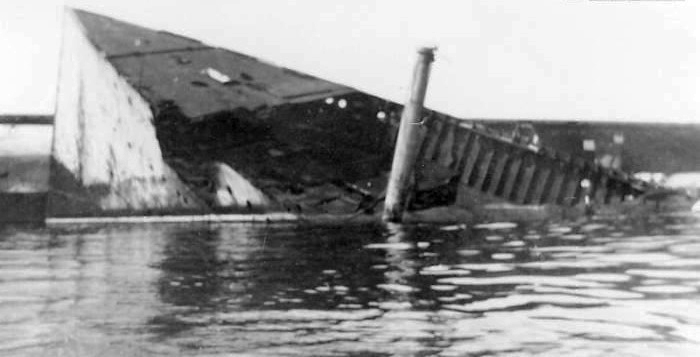
Read More/Src
Conway’s all the world’s fighting ships 1922-1947
A. Pelliccia, Il periodo epico dell’Aeronautica, Veant, 1985.
Progetto Gagnotto – 1936, Progetto Bozzoni: La portaerei Aquila.
//en.wikipedia.org/wiki/Italian_aircraft_carrier_Aquila
//www.quora.com/Why-didnt-Italy-build-aircraft-carriers-in-World-War-II
//padresteve.com/2011/01/08/the-graf-zeppelin-and-aquila-dreams-of-the-axis-carrier-ari-enthusiasts/
//www.secretprojects.co.uk/threads/the-real-sparviero-aircraft-carrier.32320/
//medium.com/@g.poggia90/the-carrier-that-never-was-1761b573311
//roetengco.blogspot.com/2012/02/regia-marina-their-aircraft-carriers-of.html
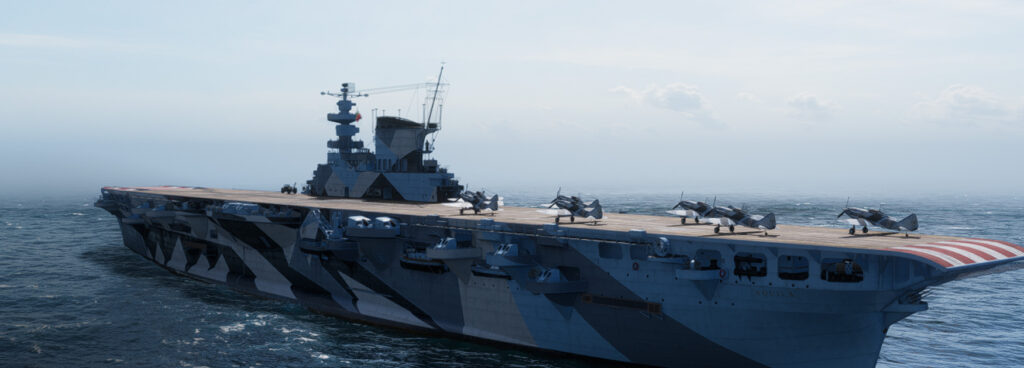

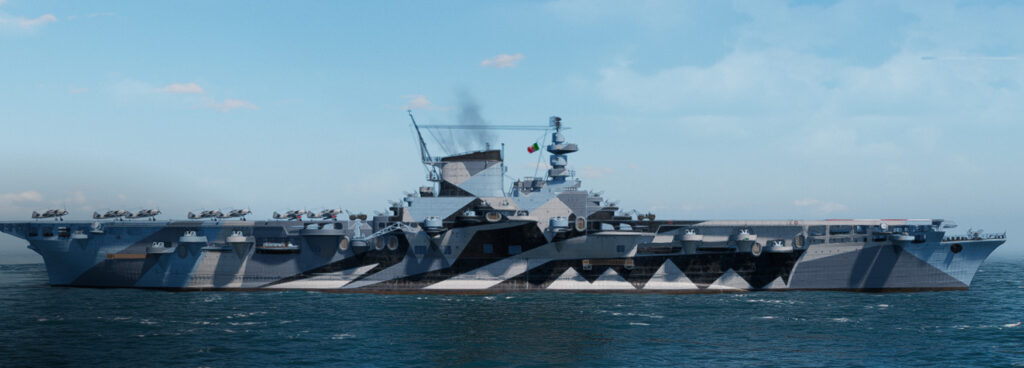
World of warships renditions if completed, camouflaged.

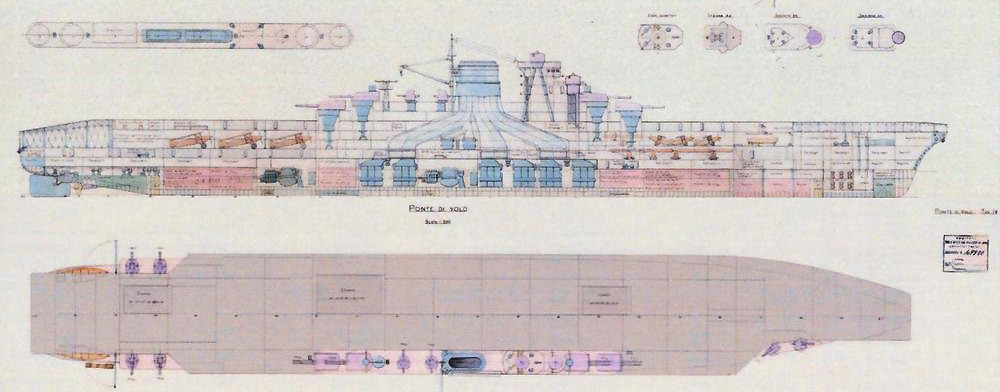
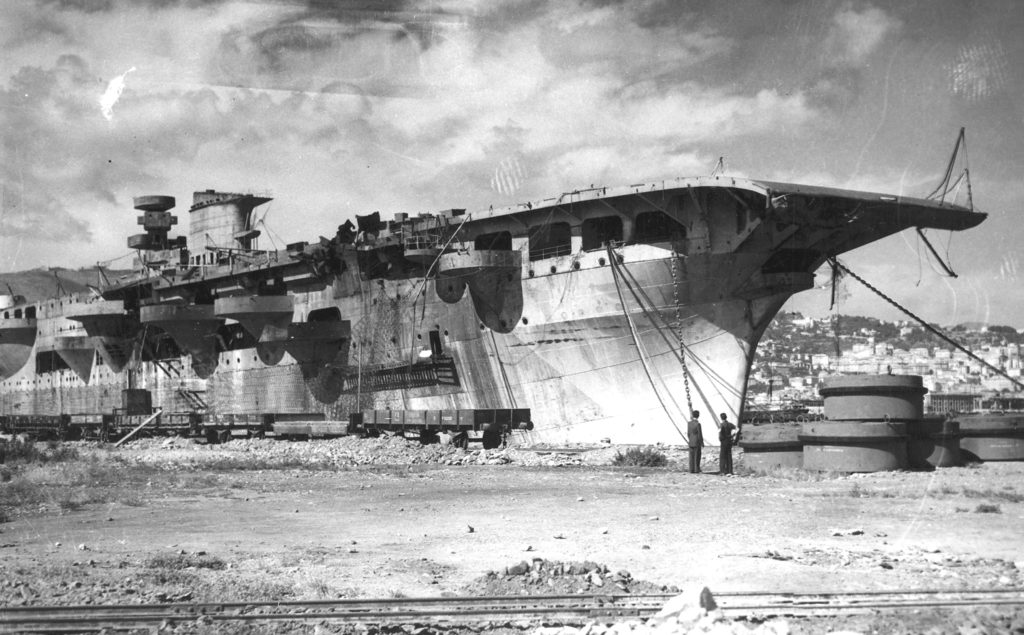
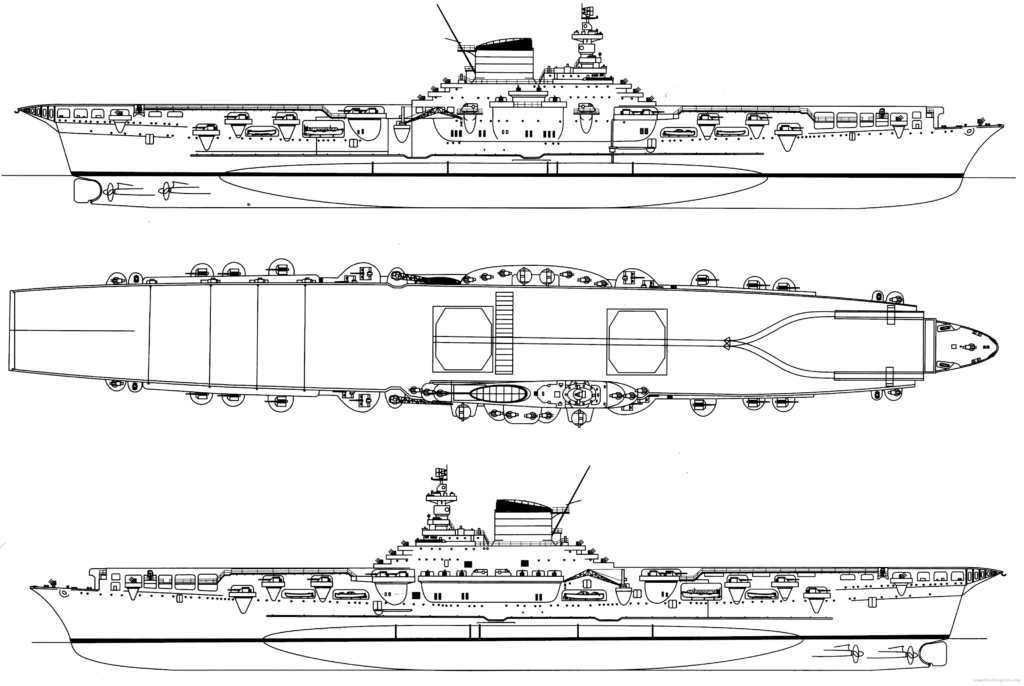

 Latest Facebook Entry -
Latest Facebook Entry -  X(Tweeter) Naval Encyclopedia's deck archive
X(Tweeter) Naval Encyclopedia's deck archive Instagram (@navalencyc)
Instagram (@navalencyc)





 French Navy
French Navy Royal Navy
Royal Navy Russian Navy
Russian Navy Armada Espanola
Armada Espanola Austrian Navy
Austrian Navy K.u.K. Kriegsmarine
K.u.K. Kriegsmarine Dansk Marine
Dansk Marine Nautiko Hellenon
Nautiko Hellenon Koninklije Marine 1870
Koninklije Marine 1870 Marinha do Brasil
Marinha do Brasil Osmanlı Donanması
Osmanlı Donanması Marina Do Peru
Marina Do Peru Marinha do Portugal
Marinha do Portugal Regia Marina 1870
Regia Marina 1870 Nihhon Kaigun 1870
Nihhon Kaigun 1870 Preußische Marine 1870
Preußische Marine 1870 Russkiy Flot 1870
Russkiy Flot 1870 Svenska marinen
Svenska marinen Søværnet
Søværnet Union Navy
Union Navy Confederate Navy
Confederate Navy Armada de Argentina
Armada de Argentina Imperial Chinese Navy
Imperial Chinese Navy Marinha do Portugal
Marinha do Portugal Mexico
Mexico Kaiserliche Marine
Kaiserliche Marine 1898 US Navy
1898 US Navy Sovietskiy Flot
Sovietskiy Flot Royal Canadian Navy
Royal Canadian Navy Royal Australian Navy
Royal Australian Navy RNZN Fleet
RNZN Fleet Chinese Navy 1937
Chinese Navy 1937 Kriegsmarine
Kriegsmarine Chilean Navy
Chilean Navy Danish Navy
Danish Navy Finnish Navy
Finnish Navy Hellenic Navy
Hellenic Navy Polish Navy
Polish Navy Romanian Navy
Romanian Navy Turkish Navy
Turkish Navy Royal Yugoslav Navy
Royal Yugoslav Navy Royal Thai Navy
Royal Thai Navy Minor Navies
Minor Navies Albania
Albania Austria
Austria Belgium
Belgium Columbia
Columbia Costa Rica
Costa Rica Cuba
Cuba Czechoslovakia
Czechoslovakia Dominican Republic
Dominican Republic Haiti
Haiti Hungary
Hungary Honduras
Honduras Estonia
Estonia Iceland
Iceland Eire
Eire Equador
Equador Iran
Iran Iraq
Iraq Latvia
Latvia Liberia
Liberia Lithuania
Lithuania Mandchukuo
Mandchukuo Morocco
Morocco Nicaragua
Nicaragua Persia
Persia San Salvador
San Salvador Sarawak
Sarawak Uruguay
Uruguay Venezuela
Venezuela Zanzibar
Zanzibar Warsaw Pact Navies
Warsaw Pact Navies Bulgaria
Bulgaria Hungary
Hungary

 Bundesmarine
Bundesmarine Dutch Navy
Dutch Navy Hellenic Navy
Hellenic Navy Marina Militare
Marina Militare Yugoslav Navy
Yugoslav Navy Chinese Navy
Chinese Navy Indian Navy
Indian Navy Indonesian Navy
Indonesian Navy JMSDF
JMSDF North Korean Navy
North Korean Navy Pakistani Navy
Pakistani Navy Philippines Navy
Philippines Navy ROKN
ROKN Rep. of Singapore Navy
Rep. of Singapore Navy Taiwanese Navy
Taiwanese Navy IDF Navy
IDF Navy Saudi Navy
Saudi Navy Royal New Zealand Navy
Royal New Zealand Navy Egyptian Navy
Egyptian Navy South African Navy
South African Navy






























 Ukrainian Navy
Ukrainian Navy dbodesign
dbodesign